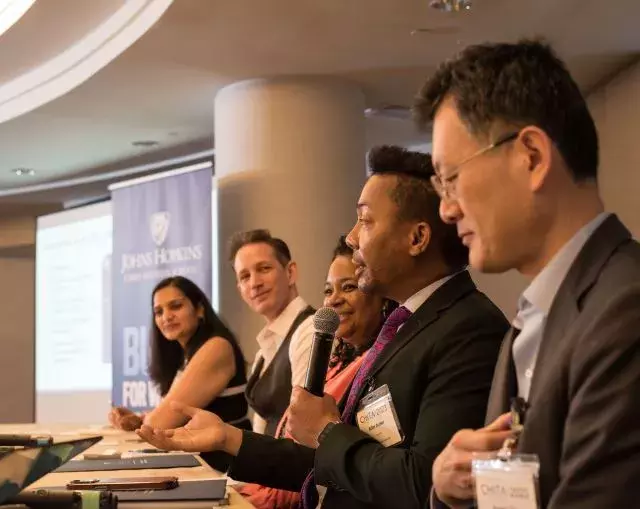The annual Conference on Health Information Technology and Analytics (CHITA) sparks ideas for the not-so-distant future of high-tech health care delivery

Leading researchers gather to advance the promise of digital technologies and AI in health care
As urgent questions swirl around the ethics of artificial intelligence, 147 of the nation’s top researchers in digital health convened to discuss its promise, its dangers, and more at the 13th annual Conference on Health Information Technology and Analytics, or CHITA, last month.
Hosted by the Johns Hopkins Carey Business School Center for Digital Health and Artificial Intelligence and supported in part by the US Agency for Healthcare Research and Quality, the conference highlighted challenges and opportunities for advancing digital health technologies, machine learning, and artificial intelligence.
U.S. Deputy National Coordinator for Health Information Technology Steven Posnack set the stage in his keynote speech by emphasizing the importance of explicit guidelines, which CDHAI Director and Wm. Polk Carey Distinguished Professor Ritu Agarwal knows exceedingly well.
“There is a wide variety of challenges that need to be addressed by researchers and practitioners to enable further progress in the digital transformation of health care, including implementing digital technologies into clinical settings, building national-scale networks that support data exchange and integration, and capitalizing on the striking opportunities being created by developments in AI and machine learning,” said Agarwal.
Those challenges are part of the promise and peril of health care AI and machine learning. Through a staggering 70 research presentations, three keynote presentations, two panels, and a pre-conference interdisciplinary doctoral consortium, experts discussed topics ranging from online sports betting’s impact on mental health to interoperability for insights in hospital and research settings. Researchers highlighted their findings around the potential to improve patient access and health care equity. And health system leaders shared how they are leveraging AI and machine learning techniques including medical imaging, personalized treatment recommendations, telehealth, etc.
A panel discussion about federated data sets offered insights into the challenges of collecting, comparing, and analyzing real world data to inform decisions around common public health issues across the U.S and globally. Separately, Wharton PhD candidate Atiye Cansu Erol shared promising research highlighting the concerns over privacy in mental telehealth care.
“Atiye was using interesting methods to capture complex concepts like stigma that are challenging to measure, quantify, or qualify,” said Odia Kane, a doctoral candidate in health policy and management at the Johns Hopkins Bloomberg School of Public Health who attended the conference. “This presentation was a major highlight for me.”
Researchers found resonance throughout the conference around imperatives for equity in access, care, and outcomes. AI and machine learning might be self-iterating systems, but they begin with the flawed understandings of human creators.
“A lot of discussion throughout the conference surrounding fairness and bias when using artificial intelligence reminds us of being conscious of how bias can be in the background of these AI tools and models,” said attendee Angela Yang, who is studying for a PhD at Bloomberg School of Public Health.
Specific funding for minority scholars also underpins the work. The National Institutes of Health AIM-AHEAD travel grant supports opportunities for minority scholars to experience cutting-edge AI research.
"It's heartening to see our research community becoming more representative, inclusive, and diversified,” said CDHAI Co-director and Carey Business School Professor Gordon Gao.
Agarwal and Gao led the CHITA Conference along with Jeffrey McCullough of the University of Michigan and Gabriel Brat, MD, of Beth Israel Deaconess Medical Center and Harvard Medical School. In its first year at Johns Hopkins Carey Business School, the conference has retained its annual goal to assess the intersection of strategy, policy, and data to promote innovation for health systems, fortune 500 companies, etc. to identify potential opportunities within the space. CHITA routinely attracts prominent scholars from prestigious institutions like the University of Pennsylvania, the University of California San Francisco, and others. Globally, leading policy influencers, informaticists, and physician attendees join to share knowledge. This year’s conference included executive representatives from IBM, Prudential Financial, and the Centers for Disease Control and Prevention’s National Center for Health Statistics.
“The rate of research innovation within the CHITA community is truly unprecedented," Gao said. "We're seeing exceptional presentations on how to incorporate AI into physician workflows and continuing medical education.”
What to Read Next

research
Ritu Agarwal named inaugural Wm. Polk Carey Distinguished ProfessorFor doctoral candidates, the conference was an invigorating opportunity to exchange knowledge and ideas with well-established experts in the field. Candidates who presented their work had the chance to receive feedback from distinguished researchers, shaping their work for future development.
“I really enjoyed the multi-disciplinary discussions and research speakers and attendees brought to the table,” said Yang. “Parallel discussions regarding telemedicine, artificial intelligence, social media and digital health filled the two days with fruitful insights.”
Attendees said they left the conference feeling inspired to push the boundaries of innovation in health care and shape the future of digital health by leveraging AI’s potential to make patient care better. Master of Public Health and MBA dual-degree candidate Matthew Potter said the experience was motivating.
“With this being my first-time attending CHITA, it was fantastic to see the strong sense of collaboration in the research community, and to engage with top researchers in the field,” he said.


